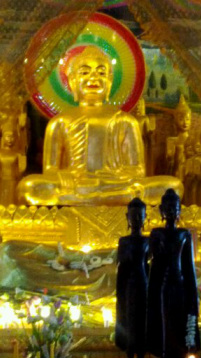
Buddha statues always seemed beneficent, those golden androgynous icons bedecked with Christmas lights whirly-gigging behind their heads. I love their heavy-lidded gaze, half-asleep smiles. What do we see when we see the Buddha? I thought the Buddha was refractive, looking inward to an inward looking inwardness. Does the Buddha also look out?
Yes, I've a passport clotted with stamps from the worlds of golden Buddhas (Thai and Khmer in particular) but I learned about "opening the eyes of the Buddha" from Anil's Ghost, Michael Ondaatje's luminous, gruesome tale of his embattled Sri Lanka. The character Anil is a diaspora Sri Lankan forensic anthropologist who returns on behalf of a human rights organization to investigate a series of murders. When she and her companion find a skeleton in an abandoned cave, Anil thinks that if the head can be reconstructed, the unknown victim can be identified. They search out Ananda, a highly regarded artisan who has the privilege of painting the eyes on the Buddha, an act that brings the statues to life. She thinks that he might also return bone to flesh. At a point in the story, Ananda speaks about his sacred work:
Yes, I've a passport clotted with stamps from the worlds of golden Buddhas (Thai and Khmer in particular) but I learned about "opening the eyes of the Buddha" from Anil's Ghost, Michael Ondaatje's luminous, gruesome tale of his embattled Sri Lanka. The character Anil is a diaspora Sri Lankan forensic anthropologist who returns on behalf of a human rights organization to investigate a series of murders. When she and her companion find a skeleton in an abandoned cave, Anil thinks that if the head can be reconstructed, the unknown victim can be identified. They search out Ananda, a highly regarded artisan who has the privilege of painting the eyes on the Buddha, an act that brings the statues to life. She thinks that he might also return bone to flesh. At a point in the story, Ananda speaks about his sacred work:
Do you know the tradition of Netra Mangala? It is a ritual of the eyes....It is always the last thing done. It is what gives the image life. Like a fuse. The eyes are a fuse.....Without the eyes there is not just blindness, there is nothing. There is no existence. The artificer brings life sight and truth and presence. (2000, p 97)
Donald Swearer refers to this quote in Becoming the Buddha, his study of Buddha statue consecration rituals in Northern Thailand, though these rites are shared in the Theravada countries of Sri Lanka, Thailand and Cambodia. Swearer's exploration the consecration ceremony is ethnographically rich and textually fascinating.
Constructing a Buddha statue is a sacred endeavor. I think of painstaking process of painting Eastern Orthodox icons or inscribing a Torah scroll where distinctive materials and ritual processes honor the sacred object. These processes connect the present to the past in what Hervieu-Legér calls a "chain of memory." The statues are modeled on earlier versions, as this continues the "chain of memory" to the original statue which is suffused with divine power because of its contact with the Buddha. This is the logic behind medieval Christian reliquaries or the Catholic notion of "apostolic succession" in which Bishops ordain a priest by a "laying of hands" to pass on the Holy Spirit that carries back in unbroken succession to Jesus laying his hands on Peter. That first lightning bolt.
How to create a Buddha statue? One must follow Theravada or Mahayana directions. The Pali Lakkhana Sutta The Marks of a Great Man lists 32 major characteristics, including legs like antelopes with heels that jut out, long fingers, soft and tender hands and feet, marked with wheels with a thousand spokes, smooth golden flawless skin, and a tight circle curl between the eyebrows. The statue is also filled with relics, texts and precious materials and possibly gems. These relics already endow the statue with a secret vibrancy, like holy organs. All these dimensions must be met, but if you have seen (and been seen) by enough Buddhas, you know that there are a multitude of various positions and mudras, and historical and regional aesthetics, such as the Sukothai, or my favorite, the Angkor era Khmer.
The Buddha's sculpting begins on an auspicious day and hour. On a final auspicious day, the sangha consecrates the statue by chanting sutras intended for the ordination of a monk. At the mundane yet remarkable moment when his eyes receive a pupil, the Buddha statue changes from inert to present. That painterly dot brings him to life. This consecration is considered an "installation of the breaths" (pranapratistha), so when the eyes are opened, breath is also endowed through the relics and sutras as a reminder to the statue of who he is.
This process, according to Bernard Faure, bestows the statue with an aura, those whirly-gigging lights or the halos around Jesus and the saints. Faure takes Walter Benjamin's notion of the aura of art objects from "The Work of Art in the Age of Mechanical Reproduction." Benjamin's notion of aura is different from this; it's about uniqueness. He argues that an original work of art is endowed with indivisibility that cannot be reproduced. Faure applies this aura to Buddhist icons that are reproduced over and over. Faure argues that the aura of religious objects set up a kind paradox of both intimacy and unapproachability, since that is the nature of a cultic object (1998). Faure considers Buddhist icons particularly in Chan Buddhism of Japan and China. I quote in length:
Constructing a Buddha statue is a sacred endeavor. I think of painstaking process of painting Eastern Orthodox icons or inscribing a Torah scroll where distinctive materials and ritual processes honor the sacred object. These processes connect the present to the past in what Hervieu-Legér calls a "chain of memory." The statues are modeled on earlier versions, as this continues the "chain of memory" to the original statue which is suffused with divine power because of its contact with the Buddha. This is the logic behind medieval Christian reliquaries or the Catholic notion of "apostolic succession" in which Bishops ordain a priest by a "laying of hands" to pass on the Holy Spirit that carries back in unbroken succession to Jesus laying his hands on Peter. That first lightning bolt.
How to create a Buddha statue? One must follow Theravada or Mahayana directions. The Pali Lakkhana Sutta The Marks of a Great Man lists 32 major characteristics, including legs like antelopes with heels that jut out, long fingers, soft and tender hands and feet, marked with wheels with a thousand spokes, smooth golden flawless skin, and a tight circle curl between the eyebrows. The statue is also filled with relics, texts and precious materials and possibly gems. These relics already endow the statue with a secret vibrancy, like holy organs. All these dimensions must be met, but if you have seen (and been seen) by enough Buddhas, you know that there are a multitude of various positions and mudras, and historical and regional aesthetics, such as the Sukothai, or my favorite, the Angkor era Khmer.
The Buddha's sculpting begins on an auspicious day and hour. On a final auspicious day, the sangha consecrates the statue by chanting sutras intended for the ordination of a monk. At the mundane yet remarkable moment when his eyes receive a pupil, the Buddha statue changes from inert to present. That painterly dot brings him to life. This consecration is considered an "installation of the breaths" (pranapratistha), so when the eyes are opened, breath is also endowed through the relics and sutras as a reminder to the statue of who he is.
This process, according to Bernard Faure, bestows the statue with an aura, those whirly-gigging lights or the halos around Jesus and the saints. Faure takes Walter Benjamin's notion of the aura of art objects from "The Work of Art in the Age of Mechanical Reproduction." Benjamin's notion of aura is different from this; it's about uniqueness. He argues that an original work of art is endowed with indivisibility that cannot be reproduced. Faure applies this aura to Buddhist icons that are reproduced over and over. Faure argues that the aura of religious objects set up a kind paradox of both intimacy and unapproachability, since that is the nature of a cultic object (1998). Faure considers Buddhist icons particularly in Chan Buddhism of Japan and China. I quote in length:
Just as the vera eikon was imbued with the power of Christ through the impression of his face, the efficacy of Buddhist icons derives from their initial contact with the Buddha. This contact, however, does not have to be with the Buddha in the flesh, since his body was already, in a sense, merely an icon or a trace, an embodiment of the truth or dharma. Other traces or substitute bodies may have a similar effect. The Buddhist tradition seems to have hesitated between two models, one that insists on the superior value of the original or historical Buddha, and another that, in an almost Derridean fashion, undermines that foundation with its emphasis on the notion of traces. After the death of the Buddha, the sacred places where his paradigmatic life had unfolded and where his stupas remained came to play a similar role in the production of presence. (Faure 2000)
This latter model of the proto-icon is based on the notion of original buddhahood. The Agama Sutra gives us the story of first Buddha statue. It's a fabulous tale that never make it into the formal philosophy we in the North attribute to Buddhism, First, the Buddha's disciples realize their "the Blessed One" has disappeared. Distressed, they consult the psychic Aniruddha who tells them that their teacher has flown off to the Trayastrimsas Heaven to teach the dharma to his dead mother, Queen Maya, perhaps so she could be relieved of samsara. There is meant as an admonishment. Since the disciples had been bickering so much, who really knows why the Buddha took off. In any case, King Udayana of Kausambi so longs for the Buddha that he falls ill. Ultimately, his family decides to have a likeness of the Buddha created to relieve the king of his longing. Maudgalyayana, another supernaturally gifted person, sends the sculptor up to the Trayastrimsas Heaven to catch a glimpse of his "Blessed" subject. The sculptor's five foot sandlewood statue is so marvelous that the king is immediately healed. When the Buddha finally returns, the statue gets up to greet his human counterpart. They talk, and the Buddha agrees that it's good to have this visual consolation as a reminder. And to think, the statue was already in place before the Buddha entered parinirvana, So "When we see statues of the Buddha, we are in essence seeing the Buddha."
Of course, the non-phenomenal Buddha nature, the Dharmakaya, is everywhere. But stories like this are quite specific about the longing for the presence of the guy , not just his idea. Like wanting to hold a photograph of the person you love. Sometimes just the aura is not enough.
Of course, the non-phenomenal Buddha nature, the Dharmakaya, is everywhere. But stories like this are quite specific about the longing for the presence of the guy , not just his idea. Like wanting to hold a photograph of the person you love. Sometimes just the aura is not enough.
Texts cited:
Swearer, Donald K. Becoming the Buddha: The Ritual of Image Consecration in Thailand. Princeton; Oxfored: Princeton University Press, 2004
Faure, Bernard, The Buddhist Icon and the Modern Gaze, Critical Inquiry, Spring 1998, Vol 24, No. 3
_____________Visions of Power: Imagining Medieval Japanese Buddhism, Translated from the French by Phyllis Brooks, Princeton: Princeton U Press, 2000
Ondaatje, Michael, Anil's Ghost, New York: Alfred Knopf, 2000

 RSS Feed
RSS Feed
